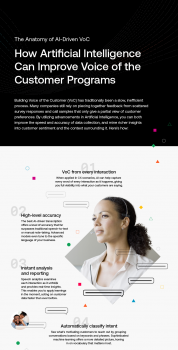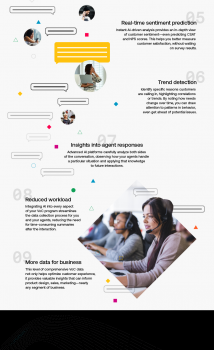Voice of the Customer (VoC) has been a nut our industry has tried to crack with varying degrees of success. Despite difficulties in uncovering it, the act of gathering VoC has always been a necessary endeavor to capture rich customer insights that guide important business changes.
Yet new advances in artificial intelligence (AI) designed for the customer experience (natural language processing (NLP), speech recognition and machine learning models) are illustrating how limited non-AI approaches have been in securing true VoC. Fraught with costly processes, manipulated survey data and delayed analysis, yesterday’s VoC falls short in both the accuracy and real-time speed that CX teams need for today’s actionable business outcomes. Today, actionable AI insights can be delivered across every interaction—whether it’s voice or digital—and can be leveraged in real-time to get CX right the first time, along with deeper analytics to get to the root of coaching historical opportunities.
The Partial View: Surveys
Many organizations build VoC programs on a “survey and score” foundation. However, because the average response rate is low, organizations have a limited view of the customer experience and quality of service that is being delivered. In addition to limited insight, the accuracy of these surveys is subject to question. In a recent survey, over 70% of agents admitted to manipulating calls to improve their performance, partly due to managerial pressures and compensation issues. With AI analysis now available on 100% of calls, managers have a new opportunity to provide holistic coaching to agents with accurate data and mitigate the performance manipulation.
So what has AI changed?
Transcription
Traditionally, transcription has been expensive and done retroactively on 10-20% of calls with varying levels of accuracy while neglecting over 80% of customer experiences. AI transcription now surpasses human capabilities in accurately transcribing both agent and customer voices to maintain the conversation context.
Not all transcription services are equal and most transcription services or Automatic Speech Recognition (ASR) models struggle with contact center telephony environments. The language used within those conversations are specific to a business. With bespoke AI models designed for a company’s lexicon, which continuously adapts to the evolving language of a business, 100% of customer engagements can be transcribed in real-time for analysis that automatically categorizes each customers’ reason for contacting your company.
This automated data analysis provides a deep understanding of customer engagement at a macro-scale provides real-time trends and anomaly detection to identify issues that could become catastrophic to a business—in addition to the insights to make changes. Agents can also leverage the transcription in real-time to deliver automatic responses, aid real-time decision making to expedite and improve the customer experience—all without a platoon of data scientists.
Rich Actionable Insights
Transcribing each conversation is only valuable when actionable insights can be pulled from the data in meaningful ways. Here are some of the following ways that accurately transcribed data can be used by AI models:
- Analyze sentiment and even predict Customer Satisfaction (CSAT) and Net Promoter Scores (NPS)
- Capture customers problem statements
- Classify intent at a useful level of detail
- Spot correlations between things – for example: callbacks or sentiment by agent, intent, or length of call
- Highlight trends and anomalies in customer conversations
- Alert supervisors of coaching need by agent or topic
- Automate summary notes, providing cleaner data for analysis and better records for future customer contact
For the first time, CX operations can measure the quality of service it is delivering for every product, interaction and every agent.
Cultivating a VoC program with AI at this depth can do more than help manage and optimize CX operations: it has the power to influence a business as a whole. When CX leaders become the ultimate advocate for customers through insightful VoC data, a business is better informed to be able to understand customers through every stage of their journey. Becoming trusted sources of insights that inform key business decisions and strategy, CX leaders have the opportunity to increase customer loyalty and revenues and deliver the promise of VoC that industry leaders have long sought to achieve.





